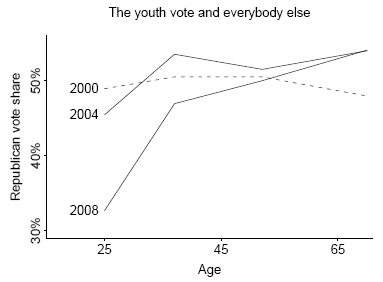
Picture from Andrew Gelman
As a sidenote to Obama's 66-32 blowout among 18-29 voters, people have been focusing on whether the youth vote was up. It was -- slightly: going from 17 to 18 percent. But the real story about the youth vote is not how many "new" voters Obama got to show up. It's how he produced a gargantuan 25% swing among existing young voters, or those who were sure to vote for the first time anyway.
How big?
18 percent times a 25 percent increase in the Democratic margin equals 4.5 points, or a majority of Obama's popular vote margin [52-46]. Had the Democratic 18-29 vote stayed the same as 2004's already impressive percentage, Obama would have won by about 2 points, and would not have won 73 electoral votes from Florida, Ohio, North Carolina, or Indiana.
So, to clarify here: Obama's youth margin = 73 electoral votes. Without the economic crisis, this would have been the difference.
Obama has reshaped the electorate. And it's been only partially through new
voter registration. He has gobbled up every last, existing
young voter.

Picture from Andrew Gelman
NEW YORK - If as the saying goes, "victory has a hundred fathers, but defeat is an orphan," among the "fathers" claiming credit for Barack Obama's triumph are different demographic groups and Democratic constituencies.
It was union members who helped make Obama president, says the AFL-CIO. It was young voters who lifted him to victory. Latinos were crucial. Single women were decisive.
But wait a minute - would Obama have won anyway without, for instance, younger voters?
AnaMaria Arumi, who directs the exit poll desk for NBC, MSNBC and Telemundo, has done the calculations based on the exit poll data and here is what she found: On a state-by-state level, when she re-ran the numbers as if there were no voters under 30, the only states that would switch to Republican presidential candidate John McCain are Indiana and North Carolina.
Without younger voters, Obama would still have won the 270 electoral votes he needs to become the next president.
It matters that Arumi did her calculations on a state-by-state basis - because it is the electoral votes of individual states and the District of Columbia and not the national popular vote that makes a candidate president.
Nationally, Obama's widest margin was among voters under 30. He won two-thirds of such voters, according to exit poll interviews.
Young voters in Virginia vs. Oklahoma
A close examination of a specific battleground state such as Virginia shows that 60 percent of Virginia voters under the age of 30 said they cast their ballots for Obama.
But for a contrast, take a state where McCain did very well, such as Oklahoma. In the Sooner State, just as in Virginia, about one-fifth of the voters were under age 30. And McCain won 60 percent of them. Not surprisingly McCain carried Oklahoma by a big margin, 32 percentage points.
So just as important as the differences between younger and older voters was simply where the voter lived: young people in Oklahoma tended to vote for McCain; young people in Virginia did not.
The problem for McCain is that there simply weren't enough young voters in other states who were like the young voters in Oklahoma.
And younger voters in a heavily Democratic state such as California were not decisive in the outcome, just as their older aunts and uncles in California were not either.
What do we really know about the votes? It's important to note that the discussion about the relative importance of one demographic group or another is based on exit poll interviews with voters.
No election official knows for certain how many people in Virginia under age 30 voted - or for whom they voted. Ballots are not marked by the voter's age or any other distinguishing factor.
And there are almost no voting precincts in the United States where 100 percent of the voters are young or black or Jewish or gun owners or members of any other single group.
Traditional voting analyses examined voting precincts that were dominated by one ethnic or religious group: voters in a predominantly Jewish precinct in the Brownsville section of Brooklyn in the 1940 election, for instance.
More recently political scientists have examined exit poll data - samples of the electorate in a state or the entire country.
What did shift is the vote preference of each group. Obama outperformed 2004 Democratic presidential nominee John Kerry with all age groups except seniors. His biggest gains were among those 25-29 years old.